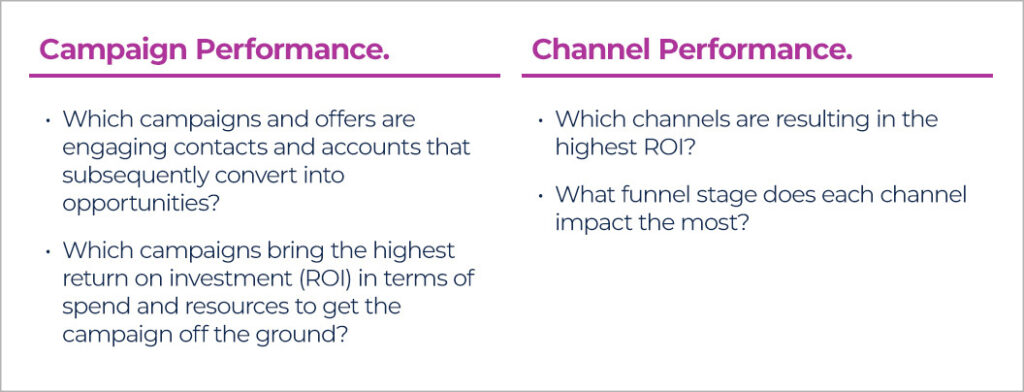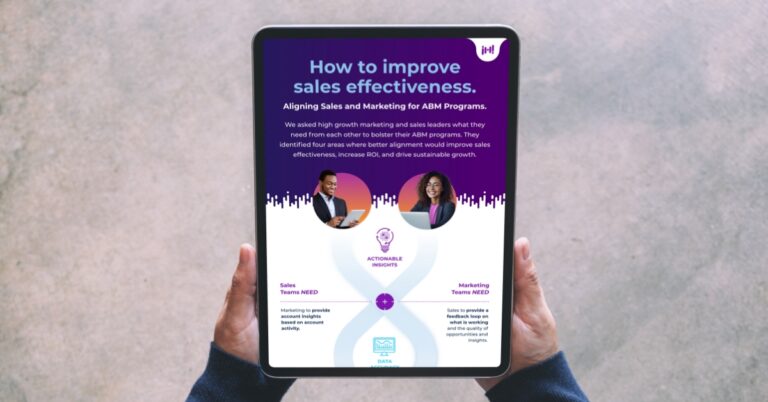Most B2B growth marketers have experienced this throughout their careers: As much effort is put into sales and marketing alignment and helping your marketing and sales teams work together, the distrust and finger pointing of which team is to blame for missing pipeline and revenue targets persists.
But what if you could change that narrative and act as one go-to-market (GTM) team that strives for the same outcomes? In Busting Silos, Snowflake’s Hilary Carpio and Travis Henry emphasize the importance of a “one-team GTM” mindset where sales and marketing are joined at the hip. This is especially important for account based marketing (ABM), which relies on your marketing and sales teams—and your customer success and partnership teams—working together to create a truly unified experience for buying teams at your target accounts.
Here are 3 signs that this full team alignment isn’t happening in your organization, and what you can do to drive the internal change necessary for ABM success.
Sign 1: Sales and marketing aren’t speaking the same language around success metrics.
Your marketing team is still reporting on top of funnel marketing metrics, such as marketing-qualified leads (MQLs) and sales accepted leads (SALs)—but your sales team is measured on bottom of funnel metrics, such as sales qualified leads (SQLs), pipeline generation, and revenue. These just do not match.
Reporting on marketing-sourced vs. sales-sourced vs. partner-sourced revenue increases misalignment and distrust between sales and marketing teams, as it encourages teams to remain siloed and operate in competition instead of collaboration. It also makes it very hard for either team to see and value the other’s contributions!
Drive change this way:
- Make pipeline generation your North Star metric. Forget about top of funnel metrics and start reporting on company growth objectives that your executive leadership, marketing, and sales teams can all fully understand and rally behind. (This is easier said than done—we have some tips on evolving marketing measurement here.) Of course you’ll also have your ultimate closed-won revenue metric, but this is pretty much a given for any organization.
- Enforce multi-touch attribution. When reporting on attribution, be intentional about not using first- or last-touch attribution data to “prove” which team gained the customer. Instead, implement a multi-touch attribution model that tells the right story about the various touch points in the buying committee’s journey with your company.
- Understand where pipeline is coming from. Regularly review campaign and channel performance metrics to make informed decisions about campaign spend, resource allocation and optimization efforts.
 Questions to ask to understand campaign and channel performance.
Questions to ask to understand campaign and channel performance.
- Provide continuous visibility into performance. Make a habit of reviewing ABM metrics with sales leaders on a weekly basis through a GTM reporting dashboard that everyone agrees on. (This could be in Salesforce, a CPD platform like Segment, or a data visualization platform like Looker.) It’s also important to provide a deeper dive into results and insights. A great way to do this is through a quarterly business review (QBR) with your larger GTM team.
Sign 2: You’re not making campaigns a collaborative effort.
As a growth marketer myself, experienced in advising revenue marketers at B2B startups, I know how much pressure marketers face from the executive leadership team to move fast. We come up with an idea, rally our agency or internal marketing team, and boom—we’re off to the races to launch a new campaign. We almost never take the time to bring the rest of the GTM team along for the journey. (I’ve been personally guilty of this.)
In the startup world you can confidently say that moving fast is a necessity. But when we pull data on all the touch points it takes for a prospect to actually convert, we see that many of them are led by Sales. Looking at it this way, it’s obvious that moving forward with a campaign without input from Sales is a mistake.
Drive change this way:
- Get ABM campaign buy-in from your sales team. Ask sales leaders and on-the-ground team members what ABM campaigns would help convert prospects into customers. What questions do they get from prospects that can be addressed in a campaign? Are there any seasonal prospect needs to be considered when planning the campaign timeline? What content or templates across the buyer’s journey do they need for their outreach? Having a clear understanding of what your sales team needs will not only help you better prioritize campaigns. This internal buy-in will also help you launch more useful campaigns that have a better chance of converting.
- Have a clear outreach plan for your GTM team. Because ABM campaigns consist of orchestrated tactics and channels that direct sales outreach efforts, these campaigns can be extra challenging for sales teams to get right. You can help by making sure Sales has everything they need to execute all their required actions. (Think: email templates, send schedules, easy-to-locate content assets.)
- Automate GTM motions. Leverage your martech stack to automate GTM motions as much as possible. For example, create replicable sales and intent email cadences in your sales engagement platforms that your sales team can easily modify and leverage in their outreach.
Sign 3: You don’t have executive buy-in to make your ABM strategy a company objective.
You’ve run an ABM pilot for a quarter, but you still don’t have any pipeline generation to show for it, thanks to your 6-to-9-month long B2B buying cycle. You believe ABM can be successful at a larger scale. But you don’t have the budget, internal resources or buy-in from your executives to make ABM a company objective.
Drive change this way:
- Showcase the entire buyer’s journey of a recent closed deal. Leverage your marketing automation platform, ABM platform, Google Analytics and Salesforce data to run a report that shows all the touch points required for that one customer to close. Data to review includes web page visits, ad engagement, sales outreach, partner outreach, customer success outreach, content engagement, direct mail engagement, and event engagement for everyone on the buying committee for that account. You’ll be surprised to see that for longer B2B buying cycles it takes more than 100, or even 200, touch points to close a deal! Put these touch points into a timeline to show your leadership team. Share the credit among your entire GTM team in your next weekly, monthly or QBR meeting. Use this report as a model for attribution on future closed deals to enhance that GTM team spirit!
- Propose a specific strategy for scaling. Propose a strategy and framework for how ABM can be successful at a larger scale within your organization. Talk to your sales team about what has worked well and what hasn’t in your pilot. Then make a data-backed recommendation for what the next iteration should look like. This could be expanding the current pilot to a larger or different audience segment; making certain technology, process or content improvements to support a larger program; or testing a different type of ABM strategy (1:1, 1:few, or 1:many). Anticipate questions your executive team will ask and be prepared to respond to them with data from the in-progress program.
- Find an ABM champion. Identify a person within your organization that believes in your vision of what you can accomplish with ABM. Work with that person to perform a small test around a specific tactic or campaign idea within your pilot. If you can show success from that initiative, it’ll be easier to get executive buy-in for your ABM strategy.
.
The Iron Horse insight.
To truly reach sales and marketing alignment around your ABM strategy, you will need to focus most of your time on advocating for your strategy internally. Meet with team members one on one to share your vision for ABM. Create workshops where you walk teams through that buyer’s journey for your last closed customer and other key insights. And, regularly present wins (regardless of how small) that can indicate success towards a more robust ABM strategy. Always err on the side of over-communication. Ultimately, ABM success depends on the level of buy-in from your executives and your GTM team members!



